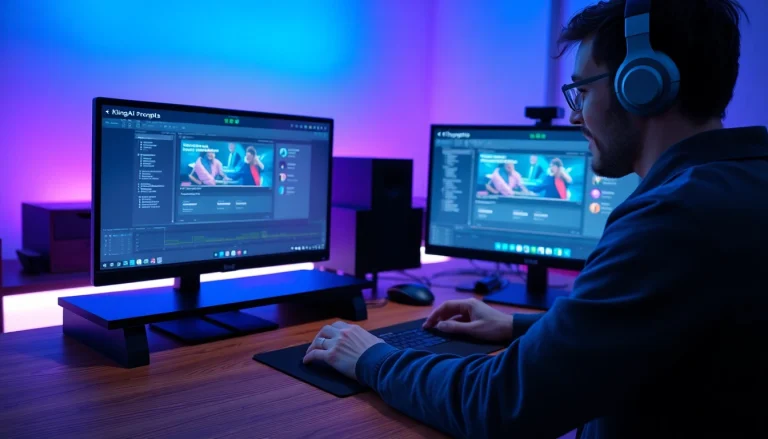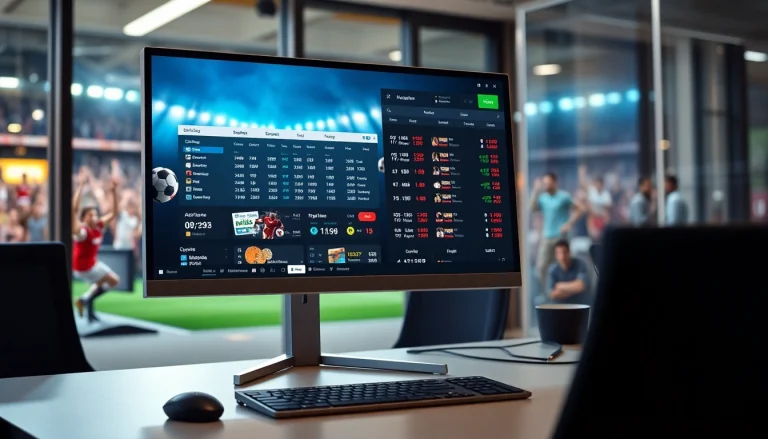Understanding KlingAI Prompts and Their Importance
KlingAI Prompts are an innovative solution in the realm of AI-assisted video production. They serve as the backbone for generating dynamic video content from text descriptions, allowing creators to bring their visions to life in ways that were once considered impossible. The advent of KlingAI has democratized video production by enabling both seasoned professionals and novices to create compelling content quickly and efficiently. By understanding and utilizing KlingAI Prompts, users can tap into a powerful resource that elevates their storytelling and enhances the visual appeal of their projects.
What are KlingAI Prompts?
KlingAI Prompts are specific textual inputs that direct the AI to generate corresponding video clips. These prompts can include details such as setting, characters, actions, and emotions that should be portrayed in the video. The flexibility and range of options provided by KlingAI allow creators to tailor their videos beyond conventional templates, effectively making each project unique. Additionally, KlingAI can incorporate advanced features like camera movements, scene transitions, and emotional nuances based on the prompts given.
Benefits of Using KlingAI Prompts
The benefits of using KlingAI Prompts are extensive, particularly for video production. Here are some key advantages:
- Time Efficiency: Most production teams spend considerable time crafting each scene manually. KlingAI automates this process, drastically reducing the time needed to produce videos.
- Cost-Effectiveness: By utilizing AI for video generation, companies can save on the costs associated with hiring talent, production crews, and expensive equipment.
- Creative Freedom: KlingAI enables users to explore various creative avenues without being constrained by traditional video-making limitations.
- Iterative Feedback: Users can quickly make adjustments to prompts and see the changes reflected in generated videos, allowing for a more iterative approach to video production.
Common Use Cases in Video Production
KlingAI Prompts have various applications across different types of video content, such as:
- Marketing Videos: Businesses can create promotional content tailored to specific campaigns or audiences, reflecting precise brand messaging and visuals.
- Social Media Content: With the demand for quick, engaging videos, KlingAI allows creators to produce eye-catching short videos that resonate with audiences.
- Education and Training: Educational institutions can develop instructional videos that make complex subjects easier to understand through visual storytelling.
- Entertainment: Creators in the field of entertainment can script narratives that are dynamically portrayed through AI-generated visuals.
Crafting Effective KlingAI Prompts
Key Principles for Writing Prompts
Crafting effective KlingAI Prompts involves a strategic approach to ensure that the produced videos meet expectations. Here are some key principles to follow:
- Be Specific: The more detailed your prompts are, the better the AI can understand and execute your vision. Include specifics about settings, characters, and actions.
- Use Descriptive Language: Vivid and descriptive language can help the AI visualize the scenes, which improves the output quality.
- Incorporate Emotional Context: Specify the emotional tone you want to convey. This can influence visual elements like colors and pacing.
- Structure Your Prompts: A well-structured prompt helps the AI interpret intent more accurately, leading to videos that align more closely with your vision.
Examples of Compelling Prompts
To illustrate the principles outlined above, consider these examples of compelling KlingAI Prompts:
- Example Prompt 1: “A dramatic sunset over a mountain range, with a traveler gazing thoughtfully into the horizon. The scene is filled with soft, warm colors and a gentle breeze.” This prompt guides the AI on both the visual and emotional tones to convey.
- Example Prompt 2: “A busy urban street, bustling with people, neon signs flashing, and the sounds of city life. Feature a slow-motion close-up of a couple laughing.” This prompts scene motion and character interaction effectively.
- Example Prompt 3: “An underwater scene showing a diver exploring a coral reef filled with vibrant fish. Add a sense of wonder and tranquility.” This example effectively combines environmental details with an emotional context.
Common Mistakes and How to Avoid Them
While KlingAI Prompts are powerful, common mistakes can hinder their effectiveness. Here’s how to avoid them:
- Being Too Vague: Avoid prompts that lack detail. For example, “A forest” is far less effective than “A foggy pine forest, with shafts of light breaking through the trees.”
- Overloading with Information: While details are important, overwhelming the AI with excessive information can lead to confusing outputs. Prioritize the essential elements.
- Neglecting Emotions: Failing to specify the emotional context can result in videos that do not resonate with viewers. Always consider the emotional impact.
- Ignoring Feedback: Use the iterative feedback capability provided by KlingAI to refine your prompts based on the AI-generated results.
Advanced Techniques for Using KlingAI Prompts
Incorporating Visual Elements in Prompts
To maximize the effectiveness of your KlingAI Prompts, incorporating visual elements thoughtfully can enhance the produced content. Consider aspects such as:
- Color Schemes: Specify the color palette for your visuals to evoke specific emotions or atmospheres.
- Camera Angles: Include descriptions of camera movements, such as “aerial view,” “close-up,” or “pan across the scene” to manipulate viewer perspective and dynamic flow.
- Specific Actions: Describing what characters are doing can fill the scene with life and movement, which the AI can visualize effectively.
- Lighting Conditions: Mentioning the type of lighting (e.g., “bright and cheerful” or “dark and moody”) can significantly impact the scene’s overall ambiance.
Using Emotional Triggers for Impact
Emotional triggers play a vital role in video creation as they can create a connection with the audience. When crafting prompts, consider leveraging emotional elements, such as:
- Contextual Scenarios: Create scenarios that resonate with common human experiences, like love, loss, triumph, or adventure.
- Character Development: Developing characters that viewers can relate to or empathize with can drive emotional engagement.
- Engaging Narration: Including narrative elements in your prompts can aid the AI in generating a cohesive story that evokes emotions.
- Sound and Music Cues: Although KlingAI primarily focuses on visuals, suggesting sound effects or musical elements can enhance the emotional landscape of the video.
Testing and Refining Your Prompts
Once initial prompts are created, testing and refining them is crucial to achieving better outcomes. Employ these strategies:
- Run Experiments: Generate multiple videos from slightly varied prompts to see which elements produce the best results.
- Seek Feedback: Share generated content with peers or target audiences to gather insights and suggestions for improvement.
- Analyze Outputs: Evaluate the videos’ quality in terms of visual fidelity, storytelling, and emotional engagement to identify prompt strengths and weaknesses.
- Iterative Improvements: Continuously refine prompts based on feedback and performance analysis, adopting a mindset of constant improvement.
Implementing KlingAI Prompts in Production Workflows
Step-by-Step Guide to Integrating Prompts
Integrating KlingAI Prompts into your production workflow can streamline processes significantly. Here’s a comprehensive step-by-step guide:
- Define Project Goals: Start by clarifying what you want to achieve with your video. Is it for marketing, education, or entertainment?
- Gather Ideas: Brainstorm concepts and themes to align with your project goals. Consider what type of content your audience engages with.
- Create Initial Prompts: Draft keyword-rich prompts focusing on specific scenes, actions, and emotions.
- Generate Videos: Use KlingAI to create videos based on your prompts, ensuring you test varied inputs for optimal output.
- Review and Edit: Analyze the generated content, making edits to prompts as necessary to enhance the final output.
- Finalize and Publish: Once you are satisfied with the generated videos, prepare them for publication, applying your branding and messaging before release.
Tools and Software for Prompt Automation
To facilitate the creation of KlingAI Prompts and video production, consider utilizing tools and software that can streamline processes, including:
- Project Management Tools: Applications like Trello or Asana can help manage workflows and keep track of prompt iterations.
- Collaboration Software: Platforms such as Slack or Microsoft Teams allow for seamless communication between team members during the production process.
- Feedback Collection Tools: Use tools like Google Forms or Typeform to gather feedback on generated videos quickly, aiding in the refinement process.
- Content Libraries: Maintain a library of effective prompts, visuals, and videos for reference and inspiration in future projects.
Case Studies of Successful Productions Using Prompts
Learning from successful implementations can provide valuable insights. Here are two example case studies that highlight the impact of KlingAI Prompts in production:
- Case Study 1: A marketing agency utilized KlingAI to generate promotional content for a product launch. By employing detailed prompts that included emotional triggers, they produced a series of engaging videos that garnered significant social media attention, resulting in a 30% increase in product purchases.
- Case Study 2: An educational institution used KlingAI to create instructional videos for a new curriculum. They developed prompts that incorporated visual elements to simplify complex topics. The result was an increase in student engagement and a notable improvement in learning outcomes.
Measuring the Effectiveness of KlingAI Prompts
Defining Success Metrics
To assess the effectiveness of KlingAI Prompts, it’s essential to define clear success metrics. These metrics may include:
- View Counts: Tracking the number of views for each video can indicate audience interest and engagement.
- Engagement Rates: Monitoring likes, shares, and comments will provide insight into how well the content resonates with viewers.
- Conversion Rates: For marketing videos, the percentage of viewers who take a desired action, such as making a purchase or signing up, serves as a key performance indicator.
- Audience Retention: Understanding how long viewers stay engaged with your videos can highlight potential areas for improvement.
Analyzing Performance Data
Regular analysis of performance data is crucial for continuous improvement in using KlingAI Prompts. Consider these analytical methods:
- Utilize Analytics Tools: Leverage tools such as Google Analytics or YouTube Analytics to gather data on viewer behavior.
- A/B Testing: Implement A/B testing by creating variations of prompts to see which versions yield better performance metrics.
- Gather Qualitative Feedback: Collect feedback from viewers through surveys or direct comments on what they enjoyed or found lacking in the videos.
- Benchmark Against Goals: Compare data against your defined success metrics to evaluate the effectiveness of your prompts and videos.
Feedback Mechanisms for Continuous Improvement
Lastly, establishing feedback mechanisms is key to refining your use of KlingAI Prompts. Explore the following approaches:
- Regular Review Meetings: Schedule meetings to discuss video performance, collect insights from team members, and brainstorm ways to improve.
- Integrate Feedback Loops: Make it easy for viewers to provide feedback directly on videos, allowing you to adapt future content based on audience preferences.
- Continuous Learning: Stay updated on new features and capabilities of KlingAI to optimize your prompt creation process.
- Document Learnings: Keep a log of what works and what doesn’t, ensuring that lessons learned contribute to better outcomes in future projects.








